
The Indian Railways may have earned more in passenger revenues in 2016-17 when compared to the previous year, but it has fallen short of its own budgeted estimates. It had projected Rs 51,012 crore but ended up earning about Rs 48,000 crore, though more than Rs 45,376 crore grossed in 2015-16 by the rail network.
The overall estimated earnings for 2016-17, including freight (Rs 1.09 lakh crore) and other receipts (Rs 11,000 crore) lifted the total earnings to Rs 1.68 lakh crore, an all-time high, reported the Economic Times.
Initiatives such as flexi fare (in Rajdhani, Shatabdi and Duronto trains) and differential pricing during the financial year 2016-17 saw its passenger earnings from reserved categories rise 6.6 percent till March 20, 2017. The Indian Railways earns about 60 percent of its revenues from reserved tickets, according to the Financial Express.
Railway Minister Suresh Prabhu said that the earnings need to be seen in the context of a challenging environment faced by the fourth-largest rail network in the world.
"Despite the most challenging environment, we have done very well. Various policy interventions at times when we could foresee slump in demand were taken, which were pivotal in bringing back the traffic," the daily quoted the minister as saying.
The operating ratio came at 95 percent, as against the 92 percent forecast by the department. The main reason was the spike in wages and salaries on account of the implementation of the 7th Central Pay Commission's recommendations.
As already known, the Indian Railways had its last separate budget last year; from the current year, it stands merged with the union budget.
The allocation for Indian Railways was raised to Rs 1,31,000 crore for FY2018, up 8.2 percent from Rs 1,21,000 crore in the previous fiscal.
One of the most significant announcements for the Indian Railways was the decision to list three rail PSU — Indian Railway Catering and Tourism Corporation, Indian Railway Finance Corporation and Ircon International Ltd.


















